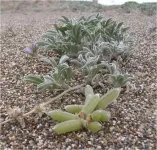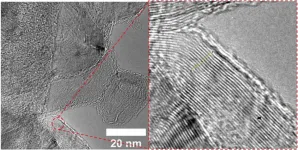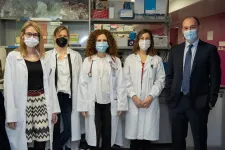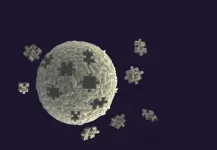(Press-News.org) Climate change is altering the world we share with all living things. But it's surprisingly difficult to single out climate change as an extinction threat for any one particular species protected under the Endangered Species Act.
To date, the U.S. Fish and Wildlife Service has only formally considered impacts from climate change in listing actions for four animal species and one alpine tree.
But the effects of climate change extend to temperate climates as well. A new analysis of population data published in the journal Ecosphere shows that climate change represents a specific extinction threat for an endangered coastal lupine plant.
Biologists including Eleanor Pardini at Washington University in St. Louis have tracked all of the known stands of Tidestrom's lupine, Lupinus tidestromii, at Point Reyes National Seashore north of San Francisco for more than 14 years.
If average temperatures increase by one degree Celsius (1° C, or about 1.8 degrees Fahrenheit) -- a conservative assumption -- the scientists project that 90% of individual lupine plants could be lost in the next 30 years.
"In general, it is fairly difficult to conclusively say that climate change is a species threat," said Pardini, assistant director of environmental studies at Washington University and senior lecturer in Arts & Sciences.
Modeling the threat of climate change requires long-term population data, which is difficult to collect and thus not available for most species.
"We were able to perform this analysis and show climate change is an important additional threat factor for this species because we have spent considerable effort collecting a long-term dataset," Pardini said.
An overlooked threat
To date, regulators have considered climate change in their listing actions only for four animal species: the polar bear, American pika, American wolverine and Gunnison sage-grouse.
Tidestrom's lupine is different, and not just because it's a plant. It's from a more seasonally mild coastal area -- not someplace that one might think would be rocked by a few degrees of rising temperatures. The animals that have been previously considered all occur in arctic, alpine or arid regions.
"While our results on L. tidestromii could be an isolated case, they suggest that the extinction threat posed by climate change might be overlooked in temperate biomes," Pardini said.
The delicate, purple-flowering lupine is part of a dune ecosystem along the west coast of the United States that is highly disturbed. In many of these coastal places, people have planted exotic plants to be able to develop and farm closer to the beach. Over time, exotic plants have over-stabilized dunes, disrupting wind and sand movement and harming plants and animals.
For the new study, Pardini worked with Tiffany Knight and Aldo Compagnoni, both of Martin Luther University Halle-Wittenberg and the German Centre for Integrative Biodiversity Research (iDiv) in Germany. Pardini and Knight have been tracking populations of Tidestrom's lupine at Point Reyes since 2005. Compagnoni joined the team as an expert in demographic modeling incorporating climate data.
The scientists produced population trajectories for all populations of the species at Point Reyes for the next 30 years.
"Using 14 years of demographic data from 2005 to 2018 and model selection, we found that survival and fertility measures responded negatively to temperature anomalies," said Compagnoni, first author of the new study. "We then produced forecasts based on stochastic individual-based population models that account for uncertainty in demographic outcomes."
If temperatures remain at the 1990-2018 average levels, the scientists expect that the number of individual lupine plants would double over the next 30 years. However, with a 1° C increase in temperature, the number of plants will instead drop off dramatically, with an expected 90% reduction in the number of individual plants.
This scenario is conservative, as even more dramatic increases in temperature than 1° C are projected for this region of California in the next 30 years.
"Despite large uncertainties, we predict that all populations will decline if temperatures increase by 1° Celsius," Compagnoni said. "Considering the total number of individuals across all seven populations, the most likely outcome is a population decline of 90%. Moreover, we predict local extinction is certain for one of our seven populations."
"Our species has a range so small that its response to climate cannot be inferred from its geographic distribution," Pardini said. "In these cases, long-term data collection becomes an important alternative option to assess the climatic vulnerability of a species."
Some rare species that are endemic to coastal habitats are currently protected by the Endangered Species Act and by various state listings.
Many Tidestrom's lupine populations are protected against development because they occur in a national park or state parks. However, Knight expressed general concern about the proposed new regulations that would allow coastal habitats to be excluded in the future because they are economically valuable to developers. Coastal plant communities provide a wide variety of valuable ecosystem services, such as mitigating the effects of coastal erosion and flooding.
INFORMATION:
HOUSTON - (March 29, 2021) - This could be where the rubber truly hits the road.
Rice University scientists have optimized a process to convert waste from rubber tires into graphene that can, in turn, be used to strengthen concrete.
The environmental benefits of adding graphene to concrete are clear, chemist James Tour said.
"Concrete is the most-produced material in the world, and simply making it produces as much as 9% of the world's carbon dioxide emissions," Tour said. "If we can use less concrete in our roads, buildings and bridges, we can eliminate some of the emissions at the very start."
Recycled tire waste is already used as a component of Portland cement, but graphene has been proven to strengthen cementitious materials, ...
SUVA, Fiji (March 29, 2021) - A new study published in the journal Environmental Science and Policy addresses the impacts of COVID-19 and Cyclone Harold on Indo-Fijians engaged in small scale fisheries.
The paper says that countries, including Fiji, need to address ethical and social justice considerations and the politics of recovery efforts by putting vulnerable and marginalized groups front and center in the aftermath of pandemics and natural disasters.
What countries cannot afford is for economic recovery efforts to put additional burdens and risk on those invested in the SSF sector, and cause further widening of inequities, and increase ...
A new study out of the University of Chicago and the University of Illinois Urbana-Champaign in humans, chimpanzees, rhesus macaques and baboons has found key differences in early gene expression in response to pathogen exposure, highlighting the importance of choosing the right animal model for the right questions. The study was published on March 26 in END ...
A national survey of parents revealed that most parents who used ride-share services did so with their children, but only half of the respondents reported that children who were 8 years or younger traveled in the recommended child car seats or booster seats when in ride-share vehicles. Among parents of children in this age group, over 40 percent used only a seat belt for their child, while 10 percent allowed their child to travel on a lap or unrestrained. Overall, parents reported lower rates of child car seat use in ride-share compared with how their child usually travels. Findings were published in the journal Academic Pediatrics.
"Our results are concerning, as ...
Barcelona researchers at the Hospital Clínic-IDIBAPS Research Institute, the University of Barcelona and the SOLTI academic cancer research group have shown that the molecular classification of breast cancer, which divides it into four subtypes (Luminal A, Luminal B, HER2-enriched and Basal-like) is useful for predicting the benefits of treatment in patients with advanced hormone-sensitive breast cancer. This is the largest study to have shown the value of the biomarker, and the first to do so in the context of a CDK4/6 inhibitor like ribociclib.
The study, published in the Journal of Clinical Oncology of the American Society of Clinical Oncology (ASCO), was coordinated by Professor Aleix Prat, head of the Medical Oncology ...
CHAPEL HILL, NC - A team led by scientists at the UNC School of Medicine discovered an important vulnerability of the AIDS-causing retrovirus HIV, and has shown in preclinical experiments that a widely used diabetes drug, metformin, seems able to exploit this vulnerability.
The scientists, whose study is published in Nature Immunology, found that HIV, when it infects immune cells called CD4 T cells, helps fuel its own replication by boosting a key process in the cells' production of chemical energy. They also found that the diabetes drug metformin inhibits the same process and thereby suppresses HIV replication in these cells, in both cell-culture and mouse experiments.
"These findings suggest that metformin and other drugs that reduce T cell metabolism ...
PHOENIX, Ariz. -- March 29, 2021 -- A review of more than 20 studies by researchers at Arizona State University and the Translational Genomics Research Institute (TGen), an affiliate of City of Hope, suggests that nonalcoholic fatty-liver disease (NAFLD) is a growing dietary problem for children across the globe.
"The prevalence of fatty-liver disease is escalating not only in adults, but also in children," said Johanna DiStefano, Ph.D., a Professor and head of TGen's Diabetes and Fibrotic Disease Unit, and the review's senior author. "Like type 2 diabetes, NAFLD used to be considered a disease that developed only in adulthood, ...
Younger trees take up and release less water than mature trees 10 years or older, researchers from North Carolina State University found in a new study that tracked how water moves through wetland pine forests near the North Carolina coast.
Their findings, published in Agricultural and Forest Meteorology, suggest managers should time timber harvests to leave older trees alongside new growth to mitigate runoff.
"The water balance, especially in coastal sites, is very important," said the study's lead author Maricar Aguilos, postdoctoral research associate in forestry and environmental resources at NC State. "We have so much water there. We wanted to understand how land-use changes impact water use and drainage in the forests, ...
Five years ago, scientists created a single-celled synthetic organism that, with only 473 genes, was the simplest living cell ever known. However, this bacteria-like organism behaved strangely when growing and dividing, producing cells with wildly different shapes and sizes.
Now, scientists have identified seven genes that can be added to tame the cells' unruly nature, causing them to neatly divide into uniform orbs. This achievement, a collaboration between the J. Craig Venter Institute (JCVI), the National Institute of Standards and Technology (NIST) and the Massachusetts Institute of Technology (MIT) Center for Bits and Atoms, was described in the journal Cell.
Identifying these genes is an important step toward engineering synthetic cells that do useful things. Such ...
Maternal socioeconomic status impacts babies even before birth, emphasizing the need for policy interventions to support the wellbeing of pregnant women, according to newly published END ...



